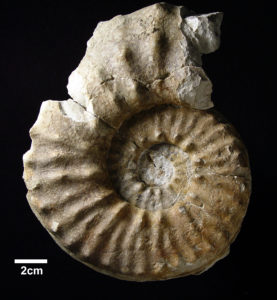Cretaceous ammonites

These snail-shaped fossils belong to the ammonites – extinct marine animals with a calcareous shell. Ammonites belong together with bivalves and gastropods to the molluscs. They are ancient relatives of the recent squids that lived in the sea 300 to 70 million years ago. This means that they became extinct at the end of the Cretaceous period, simmulateously with the extinction of the dinosaurs, however, ammonites were very successful for hundreds of million of years in evolving many thousands of species. It is the fact that their habitats declined dramatically at the end of the Cretaceous and that there was a draw-down of the sea from the continental shelves that were flooded until then. Although ammonite shells petrified as time went by, in life there were ten tentacles sticking out of the aperture.
Ammonites fed upon sealillies, ostracods, unicellular organisms and conspecific animals. Some ammonites grew very large, there are giant ammonites up to a diameter of 2.5 m. The Geosciences Collection houses thousands of ammonites of the Cretaceous period. Intensive research is going on about life-habits and evolution of these extinct animals.
 The ammonites of the Cretaceous are particularly interesting because their evolution revealsa broad variety of morphotypes. Typical for the Cretaceous are so-called heteromorph ammonites. This group is different from the “regular” snail-shape of the spiral. Straight, corkscrew or hook-shaped shells may occur. The evolutionary relationships of many groups are still unexplained today. The collections comprises of material from all over the world to know more about the evolution and geographic distribution of ammonite faunas on a global scale. However, there is a focus on some regions in the world as becomes clear from the figure. Especially comprehensive material comes from the late Late Cretaceous of North America, the Western Interior Seaway, as well as the late Early Cretaceous of Texas and France. In Germany the focus is on middle Cretaceous materials from Westphalia and Lower Saxony.
The ammonites of the Cretaceous are particularly interesting because their evolution revealsa broad variety of morphotypes. Typical for the Cretaceous are so-called heteromorph ammonites. This group is different from the “regular” snail-shape of the spiral. Straight, corkscrew or hook-shaped shells may occur. The evolutionary relationships of many groups are still unexplained today. The collections comprises of material from all over the world to know more about the evolution and geographic distribution of ammonite faunas on a global scale. However, there is a focus on some regions in the world as becomes clear from the figure. Especially comprehensive material comes from the late Late Cretaceous of North America, the Western Interior Seaway, as well as the late Early Cretaceous of Texas and France. In Germany the focus is on middle Cretaceous materials from Westphalia and Lower Saxony.
 The ammonites from Texas come from the Middle and Upper Albian as well as the lower Cenomanian of the Fort Worth area in northeastern Texas and are consequently between 95 and 100 million years old. These collections are outstanding since the ammonites have been collected bed-by-bed and are particularly well-documented. Furthermore Prof. Dr. Jens Lehmann, head of the collection, took microfossil samples simultaneously while sampling for ammonites. In co-operation with of the University of Tübingen these data sets were analysed to enable an exact comparison of the subdivision of beds by planktic foraminifers and ammonites.
The ammonites from Texas come from the Middle and Upper Albian as well as the lower Cenomanian of the Fort Worth area in northeastern Texas and are consequently between 95 and 100 million years old. These collections are outstanding since the ammonites have been collected bed-by-bed and are particularly well-documented. Furthermore Prof. Dr. Jens Lehmann, head of the collection, took microfossil samples simultaneously while sampling for ammonites. In co-operation with of the University of Tübingen these data sets were analysed to enable an exact comparison of the subdivision of beds by planktic foraminifers and ammonites.

The focus from northern Africa is mainly the ammonite faunas of the Cenomanian-Turonian of the eastern Atlas in Morocco and the Upper Barremian to Albian of the northern Sinai in Egypt. The latter have been collected in co-operation with the of Prof. J. Kuss and are currently under investigation. The faunas from France correlate to this material because some of the ammonites are of the same age. Last but not least there are a few single specimens of importance, for example a heteromorph ammonite with jaw elements in original position from the Cenomanian of Lebanon.
The ammonites from northern Germany are subdivided into material from new collections from the Pläner limestones of the Cenomanian and Turonian as well as from the Campanian. The Campanian part includes the old collections from the sandy limestones of the classical localities of the Stemwede peak, close to Haldem and Lemförde. This area, that lies nowadays between the federal states Niedersachsen and Nordrhein-Westfalen, has been collected for the city of Bremen already back in 1865. The Cretaceous ammonite collection is almost exclusively related to one person. It is the research collection of Prof. Dr. Jens Lehmann and fits perfectly into the general focus of molluscs of the collection.


